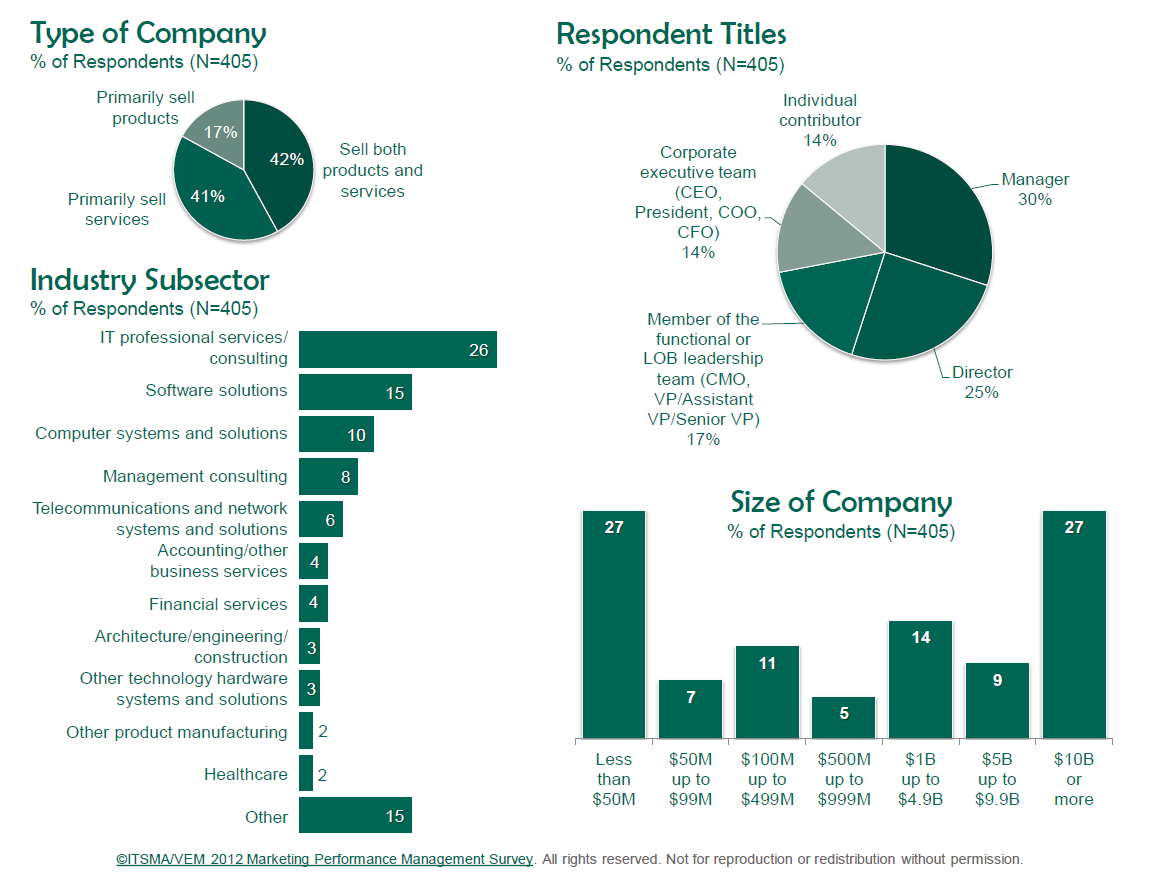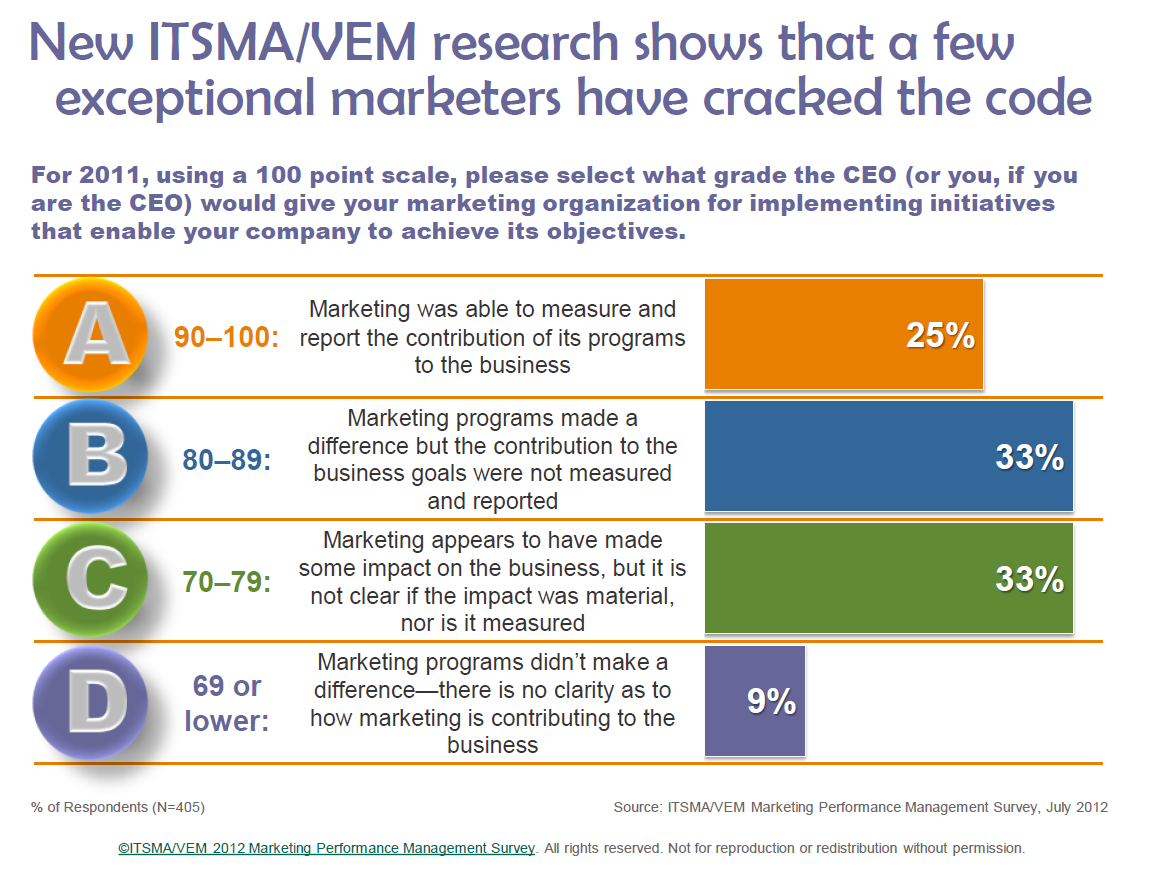Marketing Research: Only 25% of marketers can show value to the organization
Recently, I had the opportunity to speak with Julie Schwartz, Senior Vice President of Research and Thought Leadership at ITSMA (Information Technology Services Marketing Association), and Laura Patterson, President of VisionEdge Marketing. Both were involved in recent marketing research, 2012 ITSMA/VEM Marketing Performance Management Survey: The Path to Better Marketing Results.
The survey was conducted during the summer of 2012 via email and social media invitation through Twitter and LinkedIn, and included 405 completed surveys.
Here is a chart outlining details of the respondents:
All respondents were analyzed by company type, company size and by a self-grading system (grade results included, and note that “D” was the lowest possible grade):
- A – Marketing demonstrates contribution to the business: 25%
- B – Marketing makes a difference, but contribution is not measured (these marketers were considered “middle of the pack”): 33%
- C and D – Marketing may have an impact, but not known if impact is material (these marketers were considered “laggards”): 33% for “C” and 9% for “D”
Here are the key takeaways from the research:
- Marketing’s satisfaction with its ability to measure, analyze and improve performance is shockingly low
- Marketers are caught in a downward spiral as they report past performance to continually prove the value of marketing
- A few exceptional marketers have cracked the code; they excel across the board in data, metrics, processes, tools, analytical skills and reporting
- These grade “A” marketers can clearly demonstrate their value and contribution to the business
- The number of “A” marketers has remained relatively constant over time, but we see a decline in the number of “B” marketers
Because the heart of this research was marketing performance management, the self-described grades listed above were created by the key question: What grade would the C-suite give your marketing organization for its ability to demonstrate its value and impact on the business?
The missing middle
Laura says VisionEdge Marketing has been asking this question since 2001, and that the results from this year’s survey were interesting in one specific place – the number of “A” grades remained consistent with previous years, but there was a noticeable drop off in “B” grades, swelling the ranks of “C” graded marketers.
Anecdotally, she attributes this to a rough stretch for marketers in the recent past with limited budgets and external resources.
What does remain the same, Julie explains, is the research shows that all four grades of marketer are utilizing the same tools, such as marketing automation software, but that “A” marketers are achieving different, and better, results from these systems.
Julie states the big difference between “A” marketers and the rest of the field is that “A” marketers have more investment in several areas:
- Supporting infrastructure behind the technology system
- Robustness of marketing operations
- Focus on building hypotheses to use the system tools
- Sourcing talent and building their skill set
- Integration of marketing automation and the CRM
Julie adds, “We found that the marketers who received a grade of ‘A’ have much better relationships with folks at the finance organization, the IT organization and the sales organization.”
To graphically explain the results of this survey, here is a chart listing six attributes where “A” marketers excelled, along with the attributes of each grade grouping, providing a blueprint on how marketers can reach a higher grade:
Creating connections
Laura says the way for marketers not in the “A” group to improve lies in proving value to the organization.
“I don’t think we are necessarily talking about ROI so much as, ‘How do you connect?’” she states. “What investments are you making in Marketing on behalf of the company, and how do you connect those investments back to the business outcomes?”
Laura continues, “That means better dashboards, and it also means that they are leveraging their investments and systems and tools a lot better.”
Julie pointed out some metrics beyond ROI that marketers can use to make those connections:
- Incremental value to market share
- Incremental value to customer value
- Incremental value to equity of the company
Of course, at the same time, she says that Marketing also needs to maintain its internal-focused metrics to track the efficiency and productivity of individual marketing efforts.
Looking for the Grail
Julie adds that the data from this research also found that the current focus of all marketers is building skill sets and capabilities in predictive analytics – being able to build models and uncover leading indicators.
Predictive analytics is something of a Holy Grail for marketers. Yet, having reliable information based on predictive analytics gives marketers the opportunity to provide the C-suite with inputs that can be used for strategic decisions based on customer behavior and what that behavior might be in the future.
Related Resources:
Sales-Marketing Alignment: 8 tactics from a marketer who has worn both hats
Marketing Automation Vendor Selection: B2B marketer reduces unqualified leads 341%
Fostering Sales-Marketing Alignment: A 5-Step Lead Management Process
How to Predict, with 90% Accuracy, Who Your Best Customers Will Be
B2B Marketing: 7 tactics for implementing marketing automation from a fellow brand-side marketer
Categories: Research And Measurement B2B marketing, lead generation, marketing automation, Marketing Research in Action, social media monitoring













